
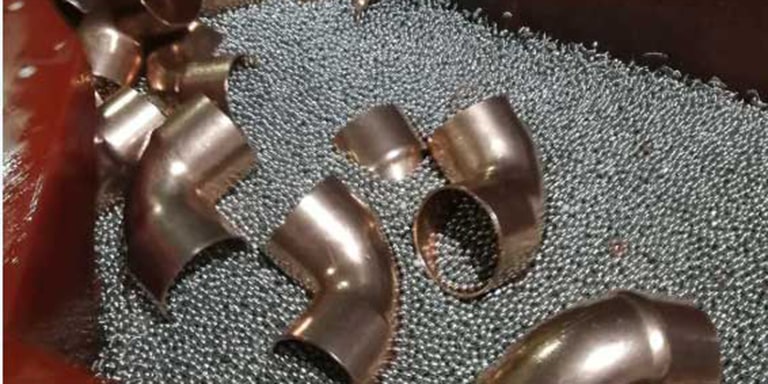 |
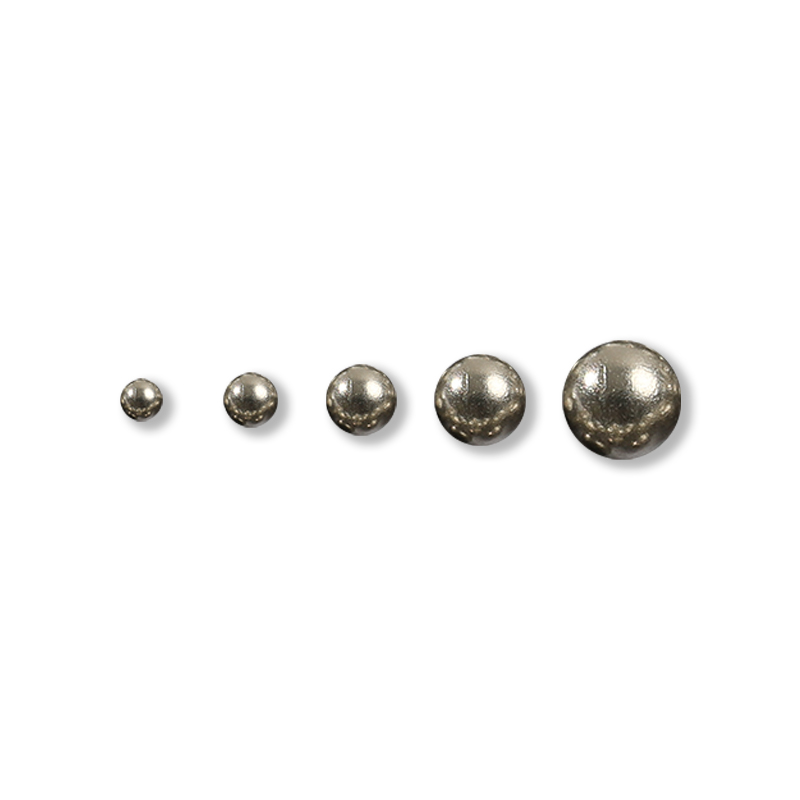 |
Manufacturing industries are under increasing pressure to produce high-quality components with improved surface properties. Traditional mechanical processes, such as turning and milling, can leave surfaces with inherent irregularities. As a result, manufacturers must find more effective finishing operations that can both eliminate these effects and improve other properties of the materials.
Surface plastic deformation processes have emerged as a solution to these challenges. Unlike traditional machining processes, these techniques do not involve material removal. Instead, the surface of the component is deformed plastically under compressive load, resulting in what is known as cold working.
One surface plastic deformation technique that has gained widespread acceptance in the manufacturing industry is burnishing. Burnishing has been used for many years and involves the application of compressive loads to the surface of a component. The resulting plastic deformation improves the surface finish and other properties of the material.
In summary, manufacturing industries face increasing expectations to produce high-quality components with improved surface properties. Surface plastic deformation processes, such as burnishing, offer an effective solution to the challenges posed by traditional machining processes.
1. What is Burnishing?Burnishing is a surface modification process that is used to achieve a smooth finish on metal surfaces. The process involves the use of a tool that rotates in a planetary motion over the surface of a turned board. Burnishing is a cold working process that smooths remove discoloration, and polishes the surface of a metal component, leaving it with a shiny finish that looks almost brand new. Burnishing specifically targets the peaks and valleys that are present on all machine or processed metal surfaces. The burnishing tool is applied with a calculated amount of force, which drives the material on the peak of the surface to flow into the valleys. This results in a reduction in the height of the peak and the depth of the valley. The burnishing process was first developed in America during the 1930s, where it was used to impart residual compressive stress to layers of various metal parts, such as railroad, car axles, and machinery shafts. Over the years, it has gained widespread acceptance and found applications in almost every industry around the world. |
|
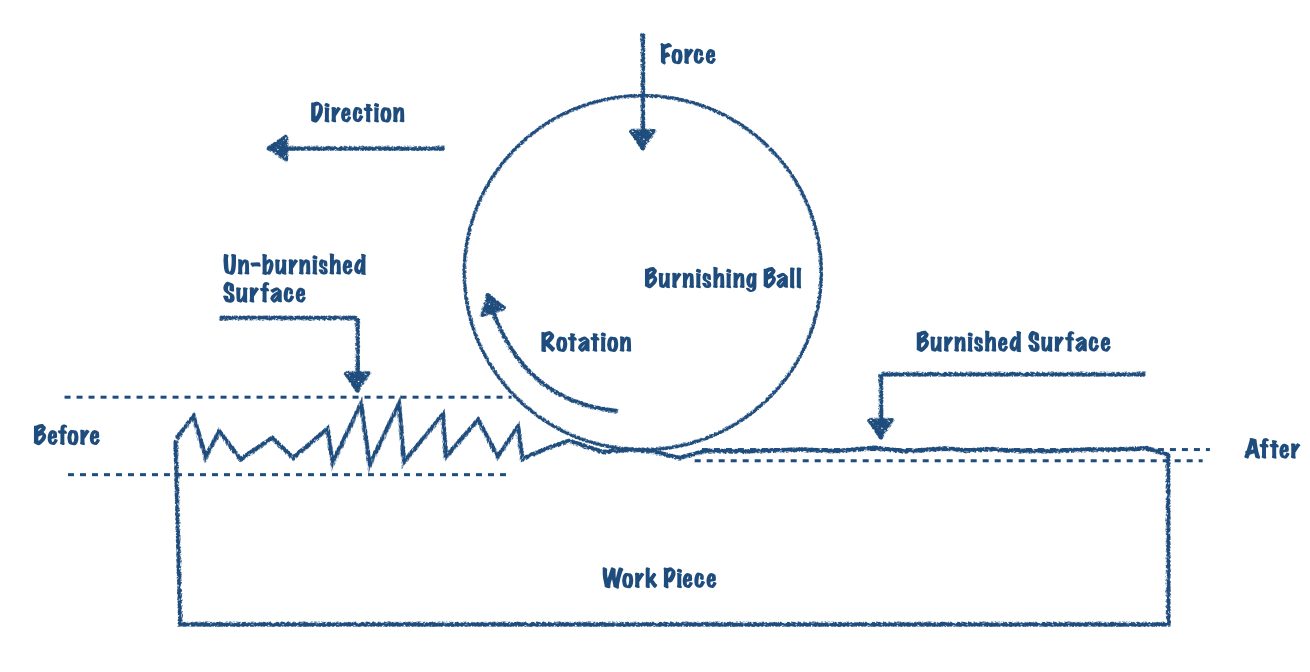 |
Burnishing is a surface modification process that can be classified into different types depending on the tools used and the geometry of the workpieces being worked on. Two of the most common types are ball burnishing and roller burnishing. In this article, we will focus on ball burnishing, its definition, advantages, and applications in various industries around the world. Ball burnishing is a type of burnishing where one or more spherical balls are supported in a shank by the hydraulic pressure of a fluid, spring, or the relative force of the workpiece. The ball is kept in constant contact with the workpiece by the fluid that is circulated using a hydraulic pump. As the tool is fed along the workpiece, the ball is pressed against it, resulting in a burnishing operation. |
The force of burnishing can be controlled by varying the hydraulic pressure of the fluid, depending on the desired effect. Ball burnishing has many advantages, including the ability to achieve a highly polished finish, increased surface hardness, improved corrosion resistance, and reduced friction.
Ball burnishing is widely used in various industries and businesses, including automotive, aerospace, medical, and electronics. In the automotive industry, ball burnishing is used to improve the surface finish and corrosion resistance of engine components, while in the aerospace industry, it is used to enhance the fatigue life of critical components. In the medical industry, ball burnishing is used to achieve a highly polished finish on surgical instruments, while in the electronics industry, it is used to improve the surface hardness and wear resistance of electronic components.
3. Advantages of Ball Burnishing3.1 Enhanced surface finish: Ball burnishing produces a very smooth surface finish that is aesthetically pleasing and improves the overall appearance of the component. 3.2 Improved fatigue life: The process induces residual compressive stresses on the surface of the component, which increases the fatigue life of the component. 3.3 Increased hardness: Ball burnishing can increase the surface hardness of the component, making it more wear-resistant. 3.4 Cost-effective: Ball burnishing is a cost-effective method of surface finishing when compared to other surface finishing processes like grinding or polishing. 3.5 Versatile: The process can be used on a wide range of materials, including ferrous and non-ferrous metals, plastics, and ceramics. |
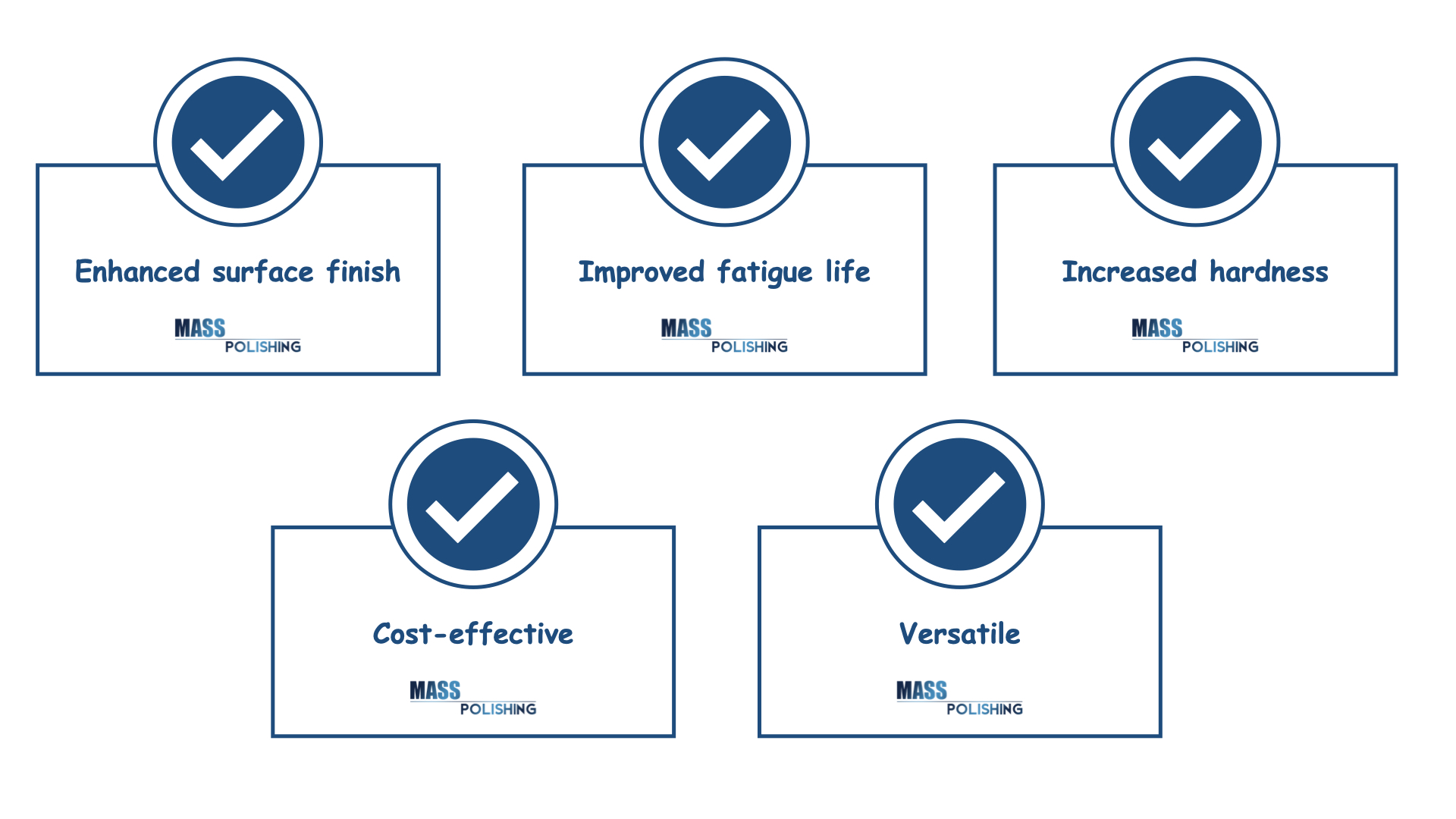 |
4. Benefits of Ball Burnishing with Stainless Steel MediaBall burnishing with stainless steel media offers several benefits that make it an attractive surface finishing option for many industries. Here are some of the benefits of ball burnishing with stainless steel media: 4.1 Reduces Porosity on Plated Parts: Stainless steel media is known for producing a smooth and consistent surface finish. Ball burnishing with stainless steel media can help achieve a mirror-like finish. 4.2 Higher Surface Pressure: Ball burnishing with stainless steel media creates a compressive force on the surface of the workpiece, which results in improved fatigue. 4.3 Improves parts performance: The process of ball burnishing with stainless steel media can help improve the corrosion resistance of parts, making them more durable and longer-lasting. 4.4 Shorter Finnish Time: The use of stainless steel media can significantly reduce the time required for surface finishing, thereby increasing production efficiency and reducing costs. 4.5 Cost-effective: Ball burnishing with stainless steel media is a cost-effective solution for achieving high-quality surface finishes. Stainless steel media has a longer lifespan and can be used multiple times, resulting in cost savings over time. |
 |
As manufacturing costs continue to rise, companies are exploring new ways to improve efficiency and maximize profits. One cost-effective solution that has gained popularity is burnishing brass components. Burnishing not only helps to repair scratches and nicks but also improves shine and extends the lifespan of machine parts and components. This has led many businesses to adopt burnishing as a preventive maintenance strategy to reduce wear and tear on their equipment.
|
5.1 Brass Fitting Parts Brass-fitting parts that undergo ball burnishing using stainless steel media have a surface that is bright and clean, in contrast to its previously dull and dark appearance. The product is now ready for market delivery. |
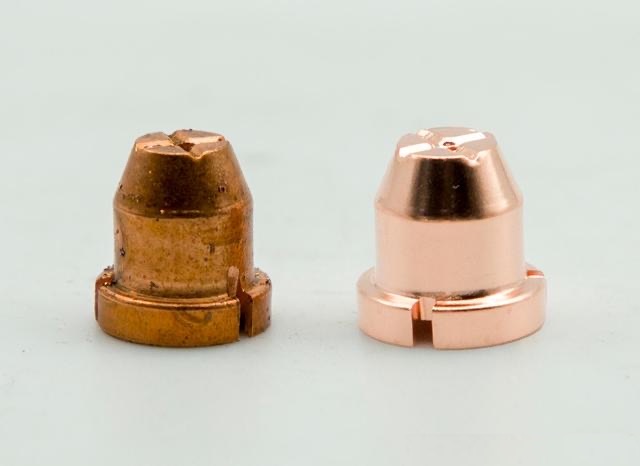 |
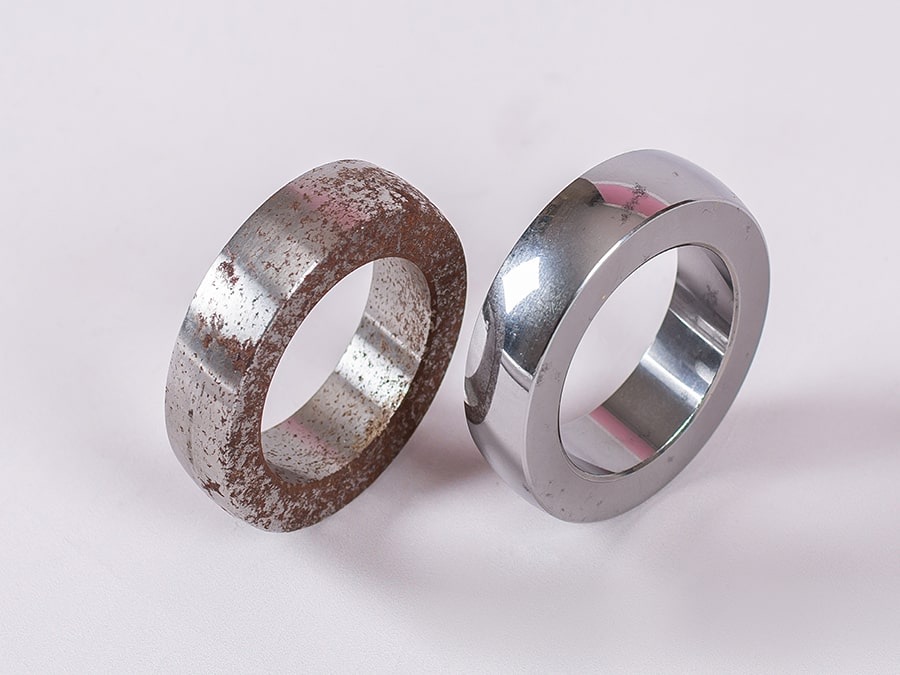 |
5.2 Steel-bearing Parts Steel-bearing parts are also effectively treated by the ball burnishing process. It not only brightens the surface but also eliminates dirt and oily substances, as demonstrated by a before-and-after comparison of the parts. |
|
5.3 Brass Stamping Parts Ball burnishing is also effective in treating brass stamping parts. Burr at the punching hole is flattened, and the dirt and oxidation layer is removed, as evidenced by a comparison of the untreated and treated parts. |
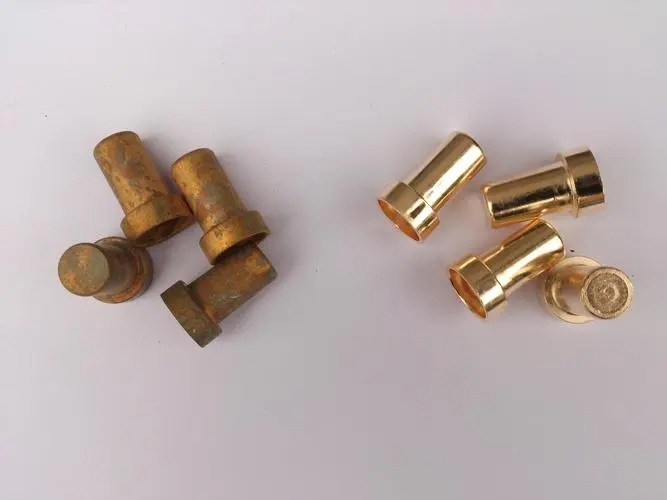 |
The use of commercial burnishing systems has effectively prolonged the lifespan of tableware in the restaurant industry.
Stainless steel burnishing has been utilized to restore the shine and beauty of various parts and components used in the automotive sector.
Aeronautic industries have benefited from the improved performance of parts achieved through stainless steel burnishing.
Stainless steel burnishing has been instrumental in repairing and restoring flatware and hollowware.
Metal serving dishes and other metal products have also been repaired and restored using stainless steel burnishing.
In summary, ball burnishing is a highly effective surface modification process that is widely used in various industries and businesses around the world. By using a hydraulic pump to circulate fluid and control the force of burnishing, ball burnishing can achieve a highly polished finish, increased surface hardness, improved corrosion resistance, and reduced friction on metal surfaces.
If you have any questions or need any help with parts surface finishing, please feel free to contact us or just send an email.